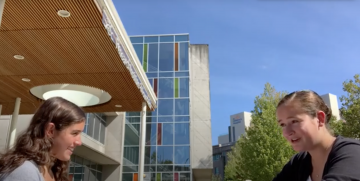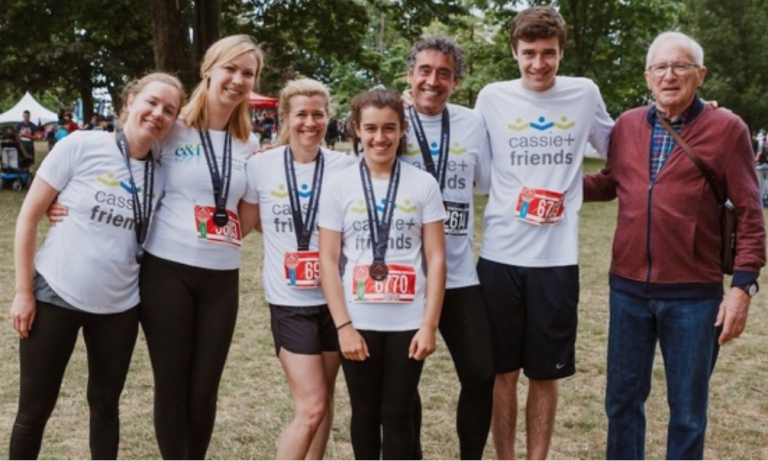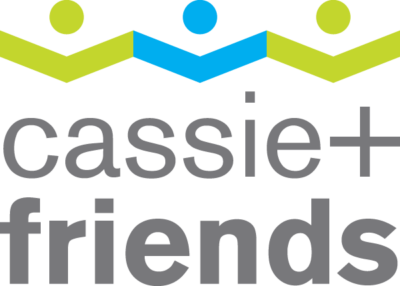 By Sarah Bowers, Junior Researcher, Brown Lab at BCCHRI
By Sarah Bowers, Junior Researcher, Brown Lab at BCCHRI
As health researchers, many of us are familiar with the term “patient-oriented” research and recognize the value of engaging various stakeholders in the research process1. But what does patient-oriented research look like in practice? Who is involved, and how do we engage other people and groups from outside our research team in our work?
I had the chance to talk about some of these questions when I met with Cassie Porte outside my team’s laboratory at BC Children’s Hospital Research Institute (BCCHRI). Cassie, now a Vancouver teen, was diagnosed with Juvenile Idiopathic Arthritis (JIA) when she was barely a toddler. Shortly after her diagnosis, Cassie’s parents established a charity called “Cassie and Friends” to make a difference in the lives of children and families living with this chronic disease. Through this platform, Cassie has been able to help other kids and families like hers living with JIA and other rheumatic diseases, know that they are not alone. For example, this summer she launched #Cassie_Talks – a web series from youth, for youth, sharing everything from tips to cope with pain, to outdoor adventure vlogs. For Cassie’s final installment of the series, she invited me to do a two-way interview with her about the research we do and how youth could get involved. Through our discussion, we explored our unique perspectives on engagement in patient-oriented rheumatology research and why it matters.
What does research look like in the Brown Lab at BC Children’s Hospital Research Institute?
This was one of Cassie’s first questions for me. I am a Junior Researcher in the Brown Lab, where we study rheumatic diseases in kids. This includes juvenile arthritis as well as other diseases, like lupus, vasculitis, and auto-inflammatory diseases. These diseases are rare in children, and there are few animal models that fully recapitulate – or “mimic” – the human diseases. Our lab has opted to take a patient-oriented approach to our research. This means that samples from patients at the hospital get taken to our lab; but more importantly, it means that the research we do on these samples has been informed by what physicians, patients and their families identify as important. Right now, for the Brown Lab, this means trying to find better ways to monitor changes in inflammation in the body, which would shift away from a “one-size-fits-all” approach to therapy. For kids and teens like Cassie, better disease control could mean fewer visits to the hospital, milder symptoms, and fewer side effects of drugs.

Cassie (left) and Sarah (right) outside BC Children’s Hospital Research Institute, discussing their unique perspectives on engagement in patient-oriented rheumatology research. Image Credit: Cassie Porte.
How do we as researchers find out what is important to patients and their families?
One of the goals of patient-oriented research is to answer questions that matter the most to patients and their families, who are experts in living with these diseases. It was important for me, a Junior Researcher, to hear from Cassie about the areas of research she identifies as important. One of Cassie’s questions is of course, “Will there ever be a cure?”, but she also sees value in making discoveries that will improve the quality of day-to-day life.
“I think kids with JIA, or teens, what they would want to be discovered would obviously be a cure, but we’re also interested in other things that could be found along the way that could be helpful . . . things that don’t have solutions yet, like nausea from methotrexate, for example, or a Humira [injection] that’s less stingy. Also, I think something that would be really cool would be if injections could be turned into pills.” – Cassie Porte
Discussions like the ones that Cassie and I had, are just one of the ways that we can engage with patients to find out what is important to them. In the Brown Lab, we participate in Family Day conferences organized by Cassie and Friends, as well as charity challenge runs and walks, where we can interact with families without the added stress and time constraints associated with clinic appointments. An increasing number of academic conferences are inviting patients or family members to speak, and we welcome participation in our research meetings. Conversely, members of the Brown Lab participate in Cassie and Friends board meetings to hear their views and needs.

Brown Lab scientists (far left), Dr Martina Sundqvist (MPharm, PhD) and Iwona Niemietz (MPharm) with Cassie Porte (centre) and her family, and (far right) pediatric rheumatologist, Dr Ross Petty (MD, PhD) at the 2019 Scotiabank Charity Challenge. Image Credit: Cassie and Friends.
How can we as researchers communicate with kids and teens, and engage them in our research?
Importantly, events and interactions where we hear from patients and their families also provide opportunities for us as researchers to share the status of our research projects. But how does Cassie, a teen, find out what we as a research community are doing to cure JIA? Or, what we’re doing to find biomarkers that would allow doctors to know what treatments are best?
“I think mostly how I find out about the research would be from my parents and also the clinic. When I go and I ask them a question, then they’re going to tell me an answer that is [based on] research.” – Cassie Porte
In the Brown Lab, we try to engage kids and teens by generating a general excitement and interest in science through outreach initiatives, including ‘Science at Home’ lab activity videos, as well as blog posts with science FAQs. However, it can be hard to gauge whether we are reaching our target audience. From Cassie’s point of view, social media is an important place to start.
“Because a lot of kids are on social media, that’s probably a good place to share it as well [to] attract more kids so they’ll see it. And also, less big words and [more] short videos, because I know I don’t have a very long attention span and a lot of kids don’t, so short videos I think would be good.” – Cassie Porte
Another great idea of Cassie’s was to create an online game that could be used to communicate research results. As a Junior Researcher, I share Cassie’s feeling that finding ways to engage people in ‘non-traditional’ ways, like communicating science on Twitter or Instagram, or through short videos, is not only important but also more fun and effective. For example, Cassie and Friends has a puppet show, Cassie and Friends at School, that has been hugely successful in raising awareness about what it is like to live with rheumatic disease.
Why is engagement in patient-oriented research important?
As evidenced in Canada’s Strategy for Patient Oriented Research2, having diverse stakeholders engaged in patient-oriented research is required to guide health research agendas and ultimately improve health outcomes for Canadians. For patients, engagement can involve numerous integral roles including but not limited to, providing input on priority areas of research and supporting studies relevant to patients, as well as collaborating on knowledge translation initiatives and helping reach diverse groups via peer networks1. For rare diseases, like pediatric rheumatic diseases, and diseases that may not be as outwardly “visible” to others, increased engagement and awareness at the community level is of particular importance to influence funding agencies to invest in research.
As a Junior Researcher, one of the ways I think we could achieve valuable growth in the number of scientists in the laboratory conducting patient-oriented research would be by introducing more educational opportunities related to patient-oriented research at the undergraduate level. This could include introductory courses on research involving patients and its ethical implications, as well as practical skills, such as qualitative data acquisition and analysis, and clinical trial design. Introducing these topics early, and not just at the graduate level or as part of supplementary training, could lead to more trainees engaging in patient-oriented research with the ultimate goal of improving health outcomes and quality of life for patients and their families.
To view Cassie and Sarah’s full #Cassie_Talks interview, follow this link.
Sarah Bowers is a recent graduate of UBC (BSc. Honors Biochemistry), a Junior Researcher in the Brown Lab at BCCHRI (www.kbrownlab.ca), and a writer and editor on the CBR KT team.
Cassie and Friends is a Canadian charity dedicated to transforming the lives of children and families affected by juvenile arthritis (JA) and rheumatic diseases. Founded in 2007, Cassie and Friends has raised over 2.5 million dollars to date for support, care, education and research. Cassie and Friend has established valued partnerships with BC Children’s Hospital, the University of British Columbia, the Michael Smith Foundation for Health Research, and SickKids Foundation.
References:
- Canadian Institutes of Health Research Strategy for Patient-Oriented Research (SPOR) – Patient Engagement Framework. Derived from the SPOR Patient Engagement consultation workshop January 2014. https://cihr-irsc.gc.ca/e/48413.html. [Online. Accessed 10 September, 2020].
- Canadian Institutes of Health Research Strategy for Patient-Oriented Research. Published August 2011. https://cihr-irsc.gc.ca/e/44000.html. [Online. Accessed 10 September, 2020].










Leave A Comment